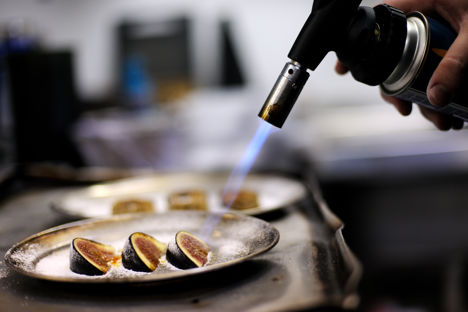Kitchen blowtorches are becoming increasingly familiar kitchen gadgets to both professional chefs and keen amateurs alike. The naked flame of a blowtorch can get much hotter than a grill, so is great for all forms of charring, caramelising and browning. Owing to the increase in production and popularity, they have come down in price a lot over the years, making them an impressive yet accessible piece of kitchen kit.
Uses
Blowtorches are traditionally used to caramelise sugar on top of a Crème brûlée, but it can be used for a lot more. They’re brilliant for lightly toasting meringues, as in Tom Aikens' Baked Alaska or Paul Ainsworth’s Raspberry meringue pies. The controlled heat applied by the blowtorch makes it perfect for unmoulding chilled desserts such as jellies, cheesecake or ice creams; it’s also useful to warm up knives to cleanly cut through frozen foods.
The blowtorch can also offer a quick option for creating a caramelised crust on meat that has been cooked in a sous vide machine, or searing the outside of fresh fish or seafood. Thomas Keller was one of the first to use the blowtorch in this way, by simply running it over the outer layer of meat to achieve the maillard reaction, creating a browned exterior. The high direct heat of a blowtorch can be also used to crisp skin from fish, poultry or meat. Blowtorches can be used for finishing off pork crackling to ensure a ‘snap’ when eating.
Blowtorches are also terrific for easily skinning peppers and tomatoes – a quick blast with a blowtorch is much quicker and easier than roasting in the oven for 15 minutes or so.
Equipment
Most blowtorches are fuelled by gasses propane or butane, so be careful when using them in cooking. Advances in technology have seen many modern blowtorches fitted with safety locks, pin-point flames and adjustable flame strength.
There are quite a few types of blowtorch on the market, with refillable cylinders, non-slip handle grips and flame control among the common features. Safety is paramount when working with naked flames. To use safely, obviously don’t touch the flame and always check the gas has been switched off before leaving the blowtorch. Always light the blowtorch before putting it near raw food, or you run the risk of getting raw fuel on the food during lighting. Make sure there is no flammable material such as alcohol nearby, and place food on a metal tray before blowtorching.
Method
The best technique to practice when using a blowtorch is to use a sweeping motion, where the flame goes slowly back and forth across the surface to evenly ‘scorch’ the food. Don’t concentrate too long on one area, or the food may burn.
Get in touch
Please sign in or register to send a comment to Great British Chefs.



